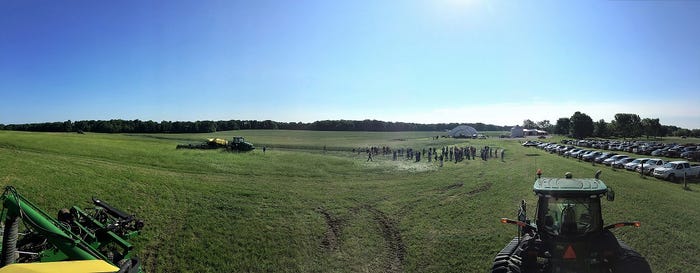February 26, 2019

Rick Clark will be recognized by the American Soybean Association during the Commodity Classic in Orlando, Fla. He is the Northeast region winner of ASA’s Conservation Legacy Award.
The award recognizes outstanding environmental and conservation achievements of soybean producers.
There’s an old saying about people who get a lot done, describing them as someone who “cuts a wide swath.” Rick Clark may not literally cut a wide swath, but he certainly rolls one — his 60-foot-wide roller/crimper creates a massive pathway when used to terminate the farm’s cover crops.
 “We have to cover a lot of ground,” he explains. “The roller needs to cover between 4,000 and 6,000 acres in a short period of time.”
“We have to cover a lot of ground,” he explains. “The roller needs to cover between 4,000 and 6,000 acres in a short period of time.”
Bigger, better, faster. Those words pretty much sum up the approach at Clark Land and Cattle, based in Warren County, Ind., operating a diverse mix of crops as well as cattle on approximately 7,000 acres of land in west-central Indiana and east-central Illinois. If you ask Clark about his farming philosophy, be warned — the answer may leave you feeling that you’re trying to sip from a firehose.

“We’re a data-driven farm, forward-thinking, focused on improving soil biology and a regenerative approach to agriculture,” he says, trying to keep it simple. “We think outside the box around here. In fact, I don’t know where the box is anymore. With all the things we’re doing, it probably is best described as ‘controlled chaos.’”
Focused farming
The fields here are large and flat — typically less than 3% slope — and the area generally receives enough rain to produce high yields. This part of the Corn Belt seems ideally suited for traditional commercial agriculture, based on big equipment and synthetic inputs. So Clark is ready for the question from visitors: What makes you think your approach is a good idea for this part of the world?
“I just show them the data,” he says. “My yields are going up while my input costs are going down. The light bulb generally comes on pretty quick after that.”
Clark represents the fifth generation of his family to farm here, as his ancestors came to west-central Indiana in the late 1800s. He farms with his father, Richard, and nephew, Aaron.
Through the years, the Clark family developed a reputation for its stewardship, and that reputation was enhanced as the operation adopted 100% no-till farming beginning in 2009, and 100% cover crops since 2013. The farm integrates wheat and alfalfa along with a corn and soybean rotation to improve biodiversity.

From there, the farm quickly fast-forwarded into advanced cover crop blends, advanced nutrient management, and techniques to build soil health, all evaluated with a focus on data collection and analysis to see what works in the system.
“We have found that ‘farming green’ is the best way to take conservation to the next level,” Clark says. “It provides soil with protective armor for up to 12 months while reducing erosion, reducing evaporation, feeding microbes, and suppressing weeds.”
The biggest step in farming green is planting green; and in Clark’s view, the greener the better. “We plant all our corn and soybeans into a living, growing cover crop,” he says. “We terminate after we plant, bringing in the roller about five days later.”
A study with an agronomy firm shows why he likes to plant in deep green conditions. “Nutrient analysis showed that cereal rye contained only about 50 pounds of N when it was 12 inches tall,” Clark says. “By 28 inches, it has 100 pounds of N, and holds 220 pounds of K2O.”
Continuing to follow the nutrient flow from the cover crop, Clark found that the cover crop had released most of its nutrients by early August. “That’s right when the soybeans need nutrients for pod fill,” he points out.

The voluminous cover crop mat also provides impressive control of weeds, including such pests as resistant marestail and waterhemp. “This has allowed us to take the farm in new directions,” Clark says. “We’re now transitioning about a third of the farm to no-till organic production, and we couldn’t do that without the weed suppression that we’re getting with cover crops.”
Another one-third of the farm devotes non-GMO production to support a nearby dairy, that provides milk for a leading yogurt manufacturer in the U.S.
Under the arrangement, Clark provides non-GMO alfalfa and corn silage for the dairy; the dairy sends back its manure nutrients to be applied to crop fields. “Getting the corn silage off early gives us a head start on our cover crop cocktails,” Clark says. “It’s also kind of cool to be providing 80% of the inputs they need to provide that non-GMO cup of yogurt.”
Spreading the word
While value-added opportunities help boost the bottom line, Clark freely shares the message that regenerative agriculture can provide positive returns to commodity production, as well. “It offers a chance to greatly reduce some of your input costs,”
he says.
Between 2011 and 2017, he points out, Clark Land and Cattle reduced its use of farm diesel fuel by 50%; synthetic fertilizer use was cut by a third; spending on ag chemicals was cut in half.
His nephew, Aaron, put together an economic analysis comparing the farm’s variable cost to produce corn with similar figures put together for more traditional corn production released by Purdue University. The Clark farm breaks even at 153 bushels per acre; the traditional high-yield system requires 224 bushels per acre.
“People ask me about yield drag in a regenerative system,” Clark says. “I’m not sure there is any, but if there is, it would be during the first three years of converting to this approach. Our yields are competitive, and our corn yields are increasing at 4.6 bushels per year; soybeans are seeing a 1.7-bushel annual increase.”
Helping to get the word out, Clark volunteered to be the host farm for the first Big Pine Creek Watershed Soil Health Field Day held in 2018; it brought in farmers from across the country. Clark also partners with organizations such as the Conservation Cropping Systems Initiative, The Nature Conservancy, and the local Soil and Water Conservation District to teach others the importance of soil health and best management practices.

“I’m just trying to figure out how to work with Mother Nature,” Clark says. “I feel that, if we use cash crop rotation and cover crop species diversification to the fullest, we can accomplish that.”
You May Also Like




